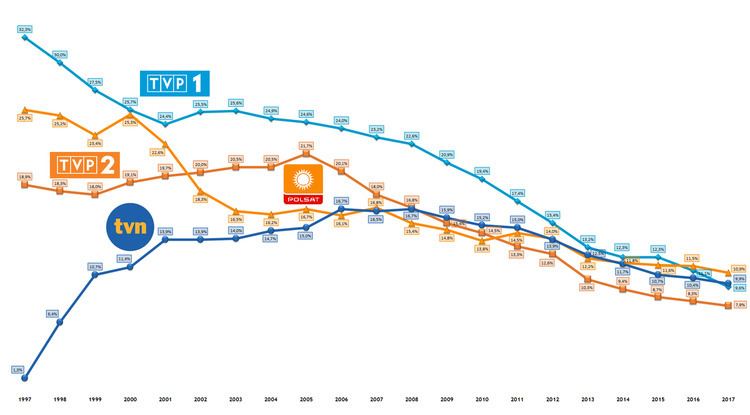 | ||
Television was introduced in Poland in 1937. It was state owned, and was interrupted by the Second World War in 1939. Television returned to Poland in 1952 and for several decades was controlled by the communist government. Colour television was introduced in Poland in 1971. Private television stations in Poland appeared around the time of the fall of communism, with PTV Echo (once a member of the local channels of Polonia 1) becoming the first private station in Poland (and in the former Eastern Bloc).
Contents
Terrestrial
Terrestrial television in Poland is broadcast using a digital DVB-T system. First test DVB-T emission was carried in Warsaw at 9 November 2001. In April 2004, first DVB-T transmitter near Rzeszów started operation, and local TVP division started to market set-top boxes allowing to receive it. As of July 2016, there are about 250 DVB-T transmitters operating in Poland, broadcasting up to three multiplexes (except local stations), all using MPEG-4 AVC compression. Two channels, TVP1 and TVP2 are available in HD across all of Poland, while several others (Polsat, TVN and TVN7) broadcast in HD in some local multiplexes. Analog terrestrial transmissions were terminated in 2013.
First efforts to introduce DVB-T in Poland was made in 1997 in Gdańsk on initiative of TVP (Polish public television broadcaster).
Allocation
At 2006 conference in Geneva known as GE06 Poland received eight DVB-T multiplexes—seven at UHF frequencies 470÷862 MHz (channels 21÷69) and one at VHF frequency 174÷230 MHz (channels 6÷12). Since some of these frequencies are currently used for analog PAL terrestrial television broadcasting, it is possible to run only two nationwide multiplexes (MUX1, MUX2) and one (MUX3) which covers part of country (58% of population). Introduction of all multiplexes will be possible after switching off analog broadcasting.
A government document entitled “Country digitalization schedule”, dated January 2009, set out plan for the digital broadcast switch-on to be made in three steps and analog broadcast switch-off in six steps.
First regular digital broadcast started on 30 September 2010. Analog broadcast switch-off started on 7 November 2012 and the transition to digital broadcasting finished on 23 July 2013.
The period of time between digital broadcast switch-on and analog broadcast switch-off will allow people time to buy new integrated Digital TVs or set-top boxes.
Current status
As of July 2013:
Analog shutdown
The shutdown of analog broadcast took place in 7 steps between 7 November 2012 and 23 July 2013.
Most operators of analog cable TV are planning to continue providing analog service in their networks for an unspecified period of time.
Additional government actions
Information campaigns about analog broadcast switch-off in mass media.
Requiring electronic equipment sellers to inform buyers that MPEG-2 TVs and STBs are not compatible with national standard which is MPEG-4 AVC.
Financial help for poor families and seniors to buy TV or STB – ca. 250 PLN per household, totalling 475 million PLN.
Technical information
Polish digital terrestrial television broadcast uses 25 Hz H.264/AVC HDTV video, MPEG-2 Layer 2 and E-AC-3 audio, for a Baseline IRD able to decode up to 1920 × 1080 interlaced 25 Hz video pictures or 1280 × 720 progressive 50 Hz video pictures.
During tests also MPEG-2 encoding for video was used.
Assignment of channels in multiplexes
Plan from January 2009 included three nationwide multiplexes with seven SDTV channels in each:
In January 2010 new plan on introducing DVB-T was presented. Assignment of multiplexes was changed:
In June 2010 another change in assignment of multiplexes was made:
Satellite
In 1998, two DVB-S providers, Cyfra+ and Wizja TV started operation. In 2001, Wizja TV was merged into Cyfra+.
1999 saw the introduction of another platform, Polsat 2 Cyfrowy (later renamed to Polsat Cyfrowy and finally Cyfrowy Polsat), owned by Polsat, a major Polish commercial TV network. These platforms become very popular, and today, there are no Polish channels available on analogue satellite (the last one, TVN, was switched off in 2008). However, most of the satellite broadcasts in Poland are in SDTV resolution.
On 12 October 2006, ITI launched the n platform with few HD channels available, as well as - also new in Poland - video on demand functionality. Later, in December 2006, Cyfra+ also started HD broadcasts. Cyfrowy Polsat started HD broadcasts in second half of 2007.
In March 2013, as part of deeper cooperation between Canal+ Group and ITI, Cyfra+ and N were merged into NC+.
Other technologies
Some of the biggest cable operators started to provide DVB-C channels in few cities. However, most of the cable networks currently operating in Poland are purely analogue.
The largest telephone operator, Telekomunikacja Polska, introduced a new option to its Neostrada offer, the Videostrada. It allows to receive digital TV, available are most of Cyfra+ channels (the platform is known as Cyfra+DSL), as well as video on demand. It is currently available only in few biggest cities in Poland.
Several TV channels, as well as video on demand, are available in Polish mobile telephony networks. There are no currently operating dedicated mobile TV transmitters.
There are also OTT TV service providers, most famous is Polish TV Company
List of channels
This is a list of television channels that broadcast in Poland.
Telewizja Polska
* In DTH platforms as TVP3 Warszawa
** Operates as an Internet multistreaming channel
Polsat Group
TVN Group (SNI)
* TTV belongs to Stavka (51% - TVN, 49% - Besta Film)
Provisional
Viewing shares
TOP 20 of Polish TV channels from 2009 by Nielsen Media Research (in gray - channels, which were in a given year out of the TOP 20):
